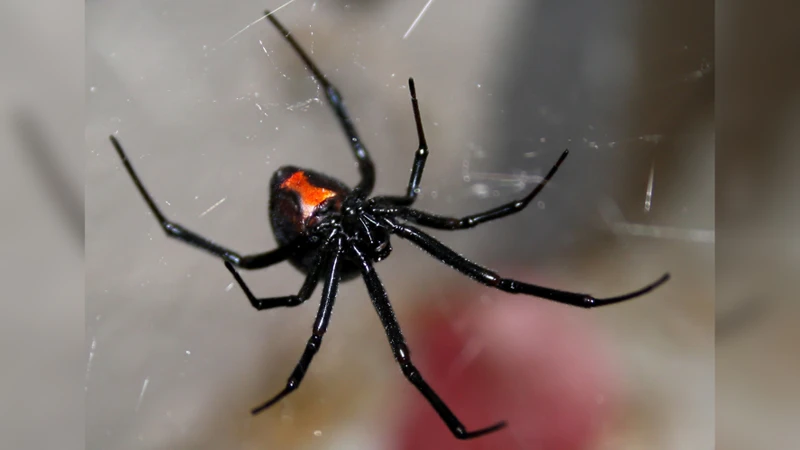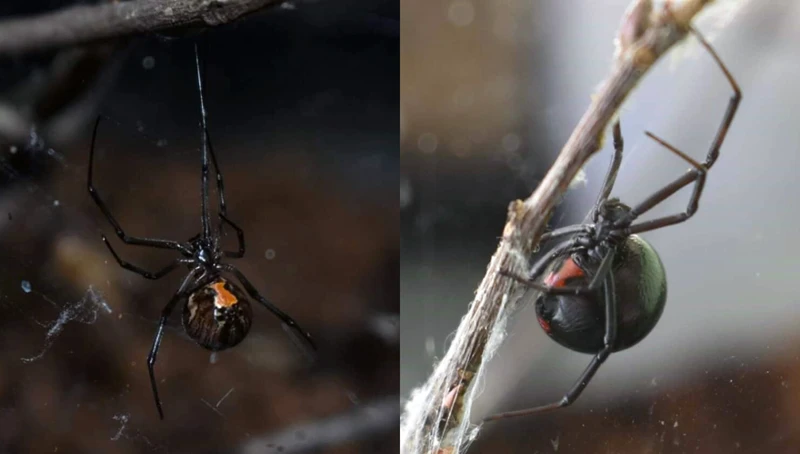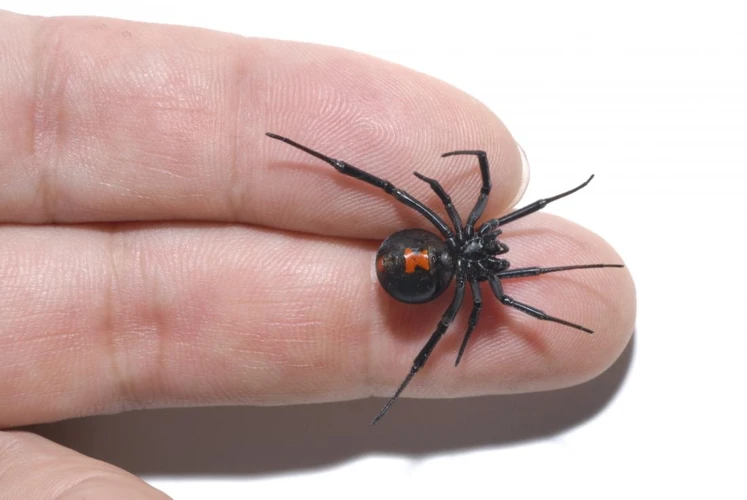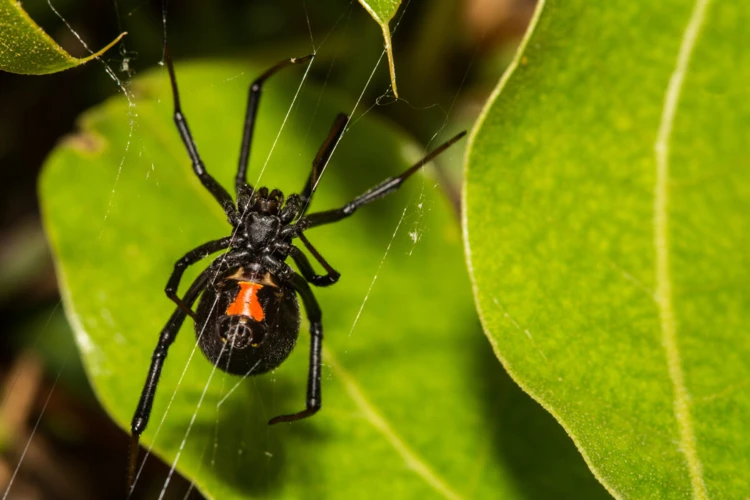As we navigate through urban areas, there are many dangers that we may encounter without even realizing it. One such danger is the presence of black widow spiders. These venomous arachnids are known to thrive in urban environments, posing a risk to both humans and pets alike. In this article, we will delve into the identification and behavior of black widow spiders, where to find them in cities, the risks associated with their bites, and most importantly, prevention tips on how to avoid these dangerous spiders altogether. So, if you’re feeling perplexed about how to navigate the concrete jungle without encountering a black widow, read on for some helpful insights.
Black Widow Spiders: Identification and Behavior

The identification and behavior of Black Widow Spiders can be perplexing to many people, given their notoriety for being venomous and dangerous. However, gaining a better understanding of what these spiders look like and how they act in their natural habitats can help individuals take important steps to avoid any potential risks. Let’s delve deeper into the identification and behavior of Black Widow Spiders without any fear.
Identification
Black widow spiders are easily recognized due to their distinctive appearance. They are usually shiny black with a red hourglass-shaped marking on their abdomen. However, not all black widow spiders have this red marking. Some may have white or yellow markings instead.
Female black widows are larger than males and can be up to 1.5 inches long, while males are typically half the size. Male black widows have longer legs than females and do not possess the red hourglass marking.
It is important to note that there are several species of widow spiders, including the brown widow spider, which may be easily confused with black widow spiders due to their similar appearance. Brown widow spiders have more of a brownish color with orange or yellow spots on their abdomen.
To identify a black widow spider, it is essential to look for the characteristic shiny black color paired with the red hourglass-shaped marking on the abdomen. If in doubt, it is best to consult a pest control professional or a spider expert.
It is also important to understand the behavior of black widow spiders. They are not particularly aggressive and tend to only bite if they feel threatened. It is recommended to avoid getting too close to them, especially in their nesting areas.
Read more: Black Widow Spiders and their risk for human envenomation
Behavior
Black widow spiders have a distinctive behavior that sets them apart from other spider species. These spiders are nocturnal and prefer dark, secluded areas, which makes encountering them particularly dangerous. Here are some interesting behavioral characteristics of black widow spiders:
| Behavioral Characteristics | Description |
|---|---|
| Web spinning | Black widow spiders build irregular webs that are usually found near ground level. They use their webs to catch their prey. |
| Mating habits | Female black widow spiders are known to eat their male counterparts after mating. Males often avoid this fate by quickly leaving the female’s web after mating. |
| Aggression | Black widow spiders are not typically aggressive towards humans unless they feel threatened. However, their venomous bite can be dangerous if they do bite. |
| Feeding habits | Black widow spiders feed on a variety of insects, such as crickets, beetles, and mosquitoes. They inject their prey with venom that helps immobilize and digest their catch. |
| Preferred habitat | Black widow spiders prefer dark, sheltered areas such as woodpiles, debris, and cluttered areas. They can also be found in undisturbed areas like sheds and garages. |
It’s important to note that while black widow spiders are more commonly found in rural areas, they can also thrive in urban environments. They are adaptable and resilient, making it imperative for people living in cities to take necessary precautions to avoid contact with these dangerous spiders.
Urban Environments and Black Widows

It may not come as a surprise that black widow spiders can be found not only in rural areas, but also in urban environments. While many may associate these venomous spiders with less populated regions, they can actually thrive in cities as well. The presence of black widow spiders in urban areas poses a potential risk to human populations. But where exactly can they be found within cities? And how do our human activities affect their behavior? Let’s explore the interaction between black widow spiders and urban environments.
Where to Find Black Widows in Cities
Black widows are commonly found in urban areas, especially in places where they can find shelter and food. They prefer warm, dry environments such as garages, sheds, and crawl spaces. They can also be found in cluttered areas, such as closets or piles of debris. Below is a table outlining common locations where black widows can be found in cities:
| Location | Description |
|---|---|
| Garages | Black widows may build webs in dark corners or behind stored items. |
| Sheds | Black widows may build webs in corners, on stored items, or in crevices. |
| Crawl spaces | Black widows may build webs in corners or under objects. |
| Closets | Black widows may build webs in corners or on stored items. |
| Piles of debris | Black widows may build webs in leaf piles, woodpiles, or piles of other outdoor debris. |
It’s important to be aware of where black widows may be found in order to avoid them and take preventative measures. For more information on black widows and their habitats, visit /habitats-black-widow-spiders/.
Black Widows and Human Activities
One fascinating aspect of black widow spiders is how they have adapted to human activities. These spiders thrive in areas where humans have altered the landscape to their advantage. For example, black widows are known to take up residence in buildings and homes, especially in warm and dry places like attics, basements, and crawl spaces. They are also commonly found in outdoor areas that are frequently disturbed, such as piles of firewood, garbage cans, and construction sites.
According to the Conservation Institute, black widows have expanded their range and become more abundant in urban areas due to human activities. As people continue to build and expand their homes and cities, they inadvertently create ideal habitat for these spiders. Additionally, climate change may also be contributing to the spread of black widows, as warmer temperatures and drought conditions promote the growth of vegetation, which in turn provides suitable shelter and food for these spiders.
Despite their adaptability to urban environments, it is important to take precautions around black widow spiders to avoid potential bites. It is also worth noting that not all black widow populations are the same. Rural black widows may behave differently than those in urban areas, and black widows in different biomes may have unique adaptations. For example, some global black widow species in areas like Europe and Australia may have different venom than those found in North America. Additionally, habitat destruction and other environmental factors may impact the distribution and behavior of black widows.
To minimize the risks associated with black widow spiders in urban areas, it’s important to gain knowledge about their behavior and habitat preferences. Taking proactive measures to reduce their access to indoor and outdoor living spaces is key. For example, sealing cracks and gaps in homes, removing clutter and debris from outdoor areas, and regularly inspecting clothing and equipment before use can all help to prevent contact with black widow spiders.
Risks Associated with Black Widow Spider Bites

It’s crucial to understand the risks associated with black widow spider bites, as they can cause severe symptoms and even death in some cases. These spiders are found in many parts of the world, including North America, Europe, and other global locations. Although they tend to avoid humans, accidental encounters can occur, and their venom is highly toxic. In this section, we will discuss the symptoms of black widow bites, risk factors for severe reactions, and the importance of prompt treatment. Additionally, we will outline prevention tips to minimize the likelihood of encountering these spiders.
To read more about the distribution of black widow spiders around the world, check out our article on global black widow spiders.
Symptoms of Black Widow Bites
Black Widow spiders are known for their venomous bite, which can cause a range of symptoms in humans. If you are bitten by a Black Widow, you may experience the following symptoms:
- Pain: The bite itself may be painful, and the pain can spread to other areas of the body.
- Muscle cramps: This is one of the most common symptoms of a Black Widow bite. You may experience muscle cramps and spasms, which can be severe.
- Sweating: The bite can cause excessive sweating, particularly around the bite site.
- Headache and dizziness: These symptoms can occur due to the effects of the venom on the body’s nervous system.
- Nausea and vomiting: Some people may feel sick to their stomach or vomit after a Black Widow bite.
- Abdominal pain: This symptom is common in children who are bitten by a Black Widow spider.
- High blood pressure: The venom from a Black Widow bite can cause an increase in blood pressure, which can be dangerous in people with underlying health conditions.
It is important to seek medical attention if you experience any of these symptoms after being bitten by a Black Widow spider. In severe cases, the symptoms can progress to include seizures, respiratory distress, and even death. It’s also important to note that not everyone will experience all of these symptoms, and some people may have only mild symptoms after a Black Widow bite.
If you want to know more about Black Widow spiders, their behavior, and habitat, you can read about them in our articles about Black Widow Spiders in North America, Black Widow Spiders in Europe, and how climate affects Black Widow Spiders.
Risk Factors for Severe Reactions
When it comes to black widow spider bites, some people are at a higher risk of developing severe reactions than others. Knowing the risk factors associated with these reactions can help you better protect yourself and seek prompt medical attention if need be. Below are some common risk factors for severe reactions to black widow spider bites:
| Risk Factor | Description |
|---|---|
| Young age | Children under the age of 16 are known to have a higher risk of experiencing severe symptoms after being bitten by a black widow spider. This is thought to be due to their smaller body size and weaker immune system, which can lead to a more potent venom reaction. |
| Pregnancy | Pregnant women are also at an increased risk of experiencing severe symptoms following a black widow spider bite. The venom can affect the developing fetus and cause complications during pregnancy. |
| Health Conditions | If you have pre-existing health conditions, such as respiratory or cardiovascular disease, you may be at a higher risk of experiencing severe reactions to black widow spider bites. This is because the venom can exacerbate these conditions and cause further health complications. |
| Allergies | If you have a known allergy to spider venom, you may be at a higher risk of experiencing severe reactions to black widow spider bites. Allergic reactions can be life-threatening and require immediate medical attention. |
| Delay in Treatment | If you don’t seek prompt medical attention after being bitten by a black widow spider, your risk of developing severe reactions increases. This is because the venom can spread throughout your body and cause systemic effects, which can be much more difficult to treat. |
It’s important to note that even if you don’t fall into any of the above risk categories, black widow spider bites can still be dangerous and require medical attention. If you suspect that you’ve been bitten by a black widow spider, it’s always best to seek medical attention promptly to rule out any severe reactions or complications.
Prevention Tips: How to Avoid Black Widow Spiders in Cities

If you live in an urban area where black widow spiders are common, prevention should be your first line of defense to protect yourself and your family. Fortunately, by taking some basic steps, you can significantly reduce the risk of encountering these venomous spiders. In this section, we will discuss various indoor and outdoor prevention measures you can take to avoid black widow spiders in cities. Keep reading to find out more!
Indoor Prevention Measures
When it comes to preventing black widow spiders from entering your home, there are a number of simple measures you can take to minimize your risk of an encounter. Try following these indoor prevention tips:
- Seal up any potential entry points: Black widow spiders can enter through small cracks or gaps in doors, windows, foundations, and other areas of your home. Seal these up with caulk or weather-stripping to prevent spiders from slipping in.
- Keep your home clean and clutter-free: Black widows prefer dark, secluded spaces, so keeping your house decluttered and tidy helps reduce hiding places. Regular vacuuming and dusting can also remove webs and spiders hiding in crevices.
- Store items in sealed containers: Cardboard storage boxes or paper bags can provide the perfect cozy spot for black widows to set up shop. Instead, store stuff in sealed plastic containers with tight-fitting lids. Additionally, be sure to shake out any clothing or shoes before putting them on, especially if they’ve been stored in an area where spiders are likely to be.
- Use spider repellents: You can find various sprays, powders, or ultrasonic devices that claim to repel spiders. These typically use natural ingredients like peppermint, citrus, or vinegar. However, some people report mixed results with these products, so do your research before investing in them.
- Call in professional help: If you’re dealing with a persistent infestation, it may be time to call in an exterminator. They can help identify and eliminate any hidden spider populations in your home. Additionally, if you notice any Black Widow spiders, it is best to seek professional help to remove them.
By taking these indoor prevention measures, you can greatly reduce your chances of encountering a black widow spider in your home. Remember to stay alert and keep an eye out for these spiders – spotting them early can help you avoid their potentially dangerous bites.
Outdoor Prevention Measures
Outdoor Prevention Measures against black widow spiders are essential to avoid their bites. These measures are particularly important if you are living in an area where black widows are commonly found.
One effective outdoor prevention measure is to control the clutter around your home. Black widows normally prefer dark and secluded places, so keeping outdoor areas clean and clutter-free is essential to avoid them. To assist with this, outdoor storage containers can be used to keep outdoor items well-organized and out of black widow habitats. If necessary, using outdoor lighting will help illuminate any dark areas where black widows may hide.
Another outdoor prevention measure is to seal up all potential entry points to your home. Black widows can enter through cracks and crevices in walls, doorways, and windows. This can be done using caulk or other materials that will seal off any potential entry points. Screening windows and doors and maintaining the seals can also prevent black widow entry.
It is also essential to keep your yard trimmed and well-maintained. Tall grass, weeds, and other plant growth provide habitats for spiders to live and breed. Keep bushes and other foliage pruned, and regularly remove debris from the yard to eliminate spider hiding places.
Another method of black widow prevention is to use pest control measures. This could include the use of insecticides and other treatments to control insects commonly found in outdoor areas around your home, which could be contributing to black widow populations.
Table: Outdoor Prevention Measures Against Black Widow Spiders
| Method | Description |
|——–|————-|
| Control Clutter | Keep outdoor areas clean and clutter-free. Use outdoor storage containers to keep items organized and out of black widow habitats. Use outdoor lighting to illuminate dark areas. |
| Seal Entry Points | Sealing cracks and crevices in walls, doorways, and windows to prevent black widow entry. Screening windows and doors and maintaining seals. |
| Yard Maintenance | Keep your yard trimmed and well-maintained. Remove tall grass, weeds, and other plant growth, and prune bushes and foliage regularly to eliminate spider hiding places. |
| Pest Control | Use insecticides and other treatments to control insects commonly found in outdoor areas around your home, which could be contributing to black widow populations. |
What to Do if You are Bitten by a Black Widow Spider
In the unfortunate event that you are bitten by a Black Widow spider, it is important to take immediate action. The first step is to try and remain calm, even though the bite can cause intense pain. The venom injected by the spider affects the nervous system causing severe cramps and muscle spasms, especially in the abdomen, which is why it is important to seek medical attention as soon as possible.
1. Wash the affected area with warm soapy water and apply a cold compress to reduce swelling. It is important to keep the affected limb immobilized, especially if the bite is on your arm or leg.
2. Seek medical attention immediately if you experience any of the serious symptoms associated with Black Widow bites, such as breathing difficulties, elevated heart rate, and extreme muscle pain. Treatment may include muscle relaxants, pain medication and anti-venom.
3. Do not apply a tourniquet or attempt to suck out the venom from the bite site. These methods are outdated and ineffective and can cause further injury.
4. Keep an eye on your symptoms after receiving medical treatment. Most people recover fully within a week, however, severe reactions can occur. If you experience any unexpected or worsening symptoms, contact your doctor immediately.
Black Widow spider bites are rare, and with prompt medical attention, they can be treated effectively. It is important to be aware of the risks and take necessary precautions to prevent bites from occurring in the first place.
Conclusion
After learning about black widow spiders, their identification and behavior, their presence in urban environments, the risks associated with their bites, and ways to prevent encounters, it is clear that these spiders should not be taken lightly. While encountering a black widow spider in a city is not uncommon, it is important to remember that their bites can be serious and potentially life-threatening.
Therefore, it is essential to take preventive measures both indoors and outdoors. Inside your home, seal all entry points and keep a tidy space to avoid creating breeding grounds. Outside your home, keep the area free of debris and clutter, and be cautious when working in any dark or secluded areas such as sheds or garages. Taking these measures can greatly reduce your chances of encountering black widow spiders.
In the event that you are bitten by a black widow spider, seek medical attention immediately. Symptoms such as extreme pain, muscle cramps, and sweating can quickly escalate to severe reactions, especially in vulnerable individuals such as small children or the elderly.
Remember that while black widow spiders may seem daunting, they can be avoided with the right precautions and knowledge. Stay informed and vigilant, and prioritize your safety and the safety of those around you.
Frequently Asked Questions
What do black widow spiders look like?
Black widow spiders are shiny black with a distinctive red hourglass shape on their abdomen.
Are black widow spiders dangerous?
Yes, black widow spiders are venomous and their bite can be dangerous, especially to children and the elderly.
What should I do if I find a black widow spider in my home?
Contact a pest control professional to safely remove the spider and prevent future infestations.
Where are black widow spiders commonly found in urban environments?
Black widow spiders can often be found in dark and cluttered areas such as garages, sheds, and basement corners.
How can I prevent black widow spiders from entering my home?
Seal cracks and crevices, remove clutter from around your home’s exterior, and keep doors and windows well-sealed.
What is the first aid treatment for a black widow spider bite?
Seek medical attention immediately. Over-the-counter pain relievers and ice can help alleviate symptoms until medical treatment is available.
How do black widow spiders behave around humans?
Black widow spiders are generally reclusive and avoid human contact, but can become aggressive if they feel threatened or trapped.
What are some outdoor prevention measures I can take to avoid black widow spiders?
Keep wood piles and debris away from your home’s exterior, wear gloves when gardening or handling firewood, and shake out clothing and shoes before wearing them.
How common are black widow spider bites?
Black widow spider bites are relatively rare, but can be serious if not treated promptly.
Can black widow spiders be kept as pets?
While some people do keep black widow spiders as pets, it is not recommended due to their venomous nature and potential danger to humans.






